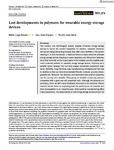Last Developments in Polymers for Wearable Energy Storage Devices

Use este enlace para citar
http://hdl.handle.net/2183/30984
Excepto si se señala otra cosa, la licencia del ítem se describe como Attribution-NonCommercial-NoDerivatives 4.0 International (CC BY-NC-ND 4.0)
Colecciones
- Investigación (EPEF) [590]
Metadatos
Mostrar el registro completo del ítemTítulo
Last Developments in Polymers for Wearable Energy Storage DevicesFecha
2022-06-25Cita bibliográfica
Lage-Rivera S, Ares-Pernas A, Abad M-J. Last developments in polymers for wearable energy storage devices. Int J Energy Res. 2022;46(8):10475‐10498. doi:10.1002/er.7934
Resumen
[Abstract] Our modern and technological society requests enhanced energy storage devices to tackle the current necessities. In addition, wearable electronic devices are being demanding because they offer many facilities to the person wearing it. In this manuscript, a historical review is made about the available energy storage devices focusing on super-capacitors and lithium-ion batteries, since they currently are the most present in the industry, and the possible polymeric materials suitable on wearable energy storage devices. Polymers are a suitable option because they not only possess remarkable mechanical resistance, flexibility, long life-times, easy manufacturing techniques and low cost in addition to they can be environmentally friendly, nontoxic, and even biodegradable too. Moreover, the electrical and electrochemical polymer properties can be tunning with suitable fillers giving to versatile conducting polymer composites with a good cost and properties' ratio. Although the advances are promising, there are still many drawbacks that need to be overcome. Future research should focus on improving both the performance of materials and their processability on an industrial scale, where additive manufacturing offers many possibilities. The sustainability of new energy storage devices should not be forgotten, encouraging the use of more environmentally friendly materials and manufacturing processes.
Palabras clave
Batteries
Energy storage
Polymer composites
Super-capacitors
Wearable
Energy storage
Polymer composites
Super-capacitors
Wearable
Descripción
Financiado para publicación en acceso aberto: Universidade da Coruña/CISUG
Versión del editor
Derechos
Attribution-NonCommercial-NoDerivatives 4.0 International (CC BY-NC-ND 4.0)
ISSN
1099-114X






